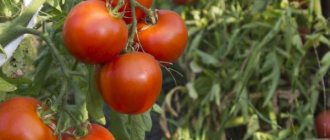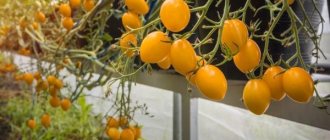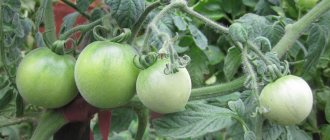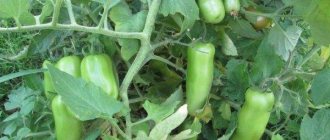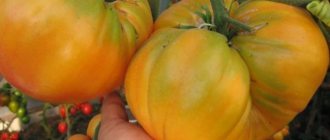Vegetable growing » Tomatoes
0
1466
Article rating
Kira Stoletova
The Ox Ears tomato is a salad tomato variety. Like any plant, this variety has advantages and disadvantages. This type of tomato is not easy to grow, but it is worth it. The Ox Ears tomato is endowed with good taste and is popular, as confirmed by the detailed description. Summer residents love this red vegetable very much and always plant it in their garden plots.
Characteristics of tomato Ox ears
Tomato Oxen's Ear: description of the variety
| Variety name | Ox Ear |
| general description | Mid-season indeterminate variety |
| Originator | Russia |
| Ripening period | 110-120 days |
| Form | Elongated with a sharp tip |
| Color | Red |
| Average weight of tomatoes | 100-140 grams |
| Application | Universal |
| Productivity of the variety | 6 kg per square meter |
| Features of cultivation | Standard agricultural technology |
| Disease resistance | Resistant to major diseases |
Tomatoes Oxen's Ear are a mid-season, high-yielding variety.
The bush is indeterminate, tall, not too branched. The formation of green mass is average, the leaves are small, dark green, the inflorescences are simple. The fruits ripen in clusters of 4-6 pieces. Productivity is good, from 1 sq. m of planting you can get more than 6 kg of selected tomatoes .
The ripening period is extended over the entire season; tomatoes are harvested at the stage of technical or physiological ripeness. The fruits are medium in size, weighing from 100 to 140 g. The shape is elongated, with a pointed tip, resembling an ear. The tomatoes are slightly ribbed at the stalk and the color is deep red.
The skin is dense, protecting the fruits from cracking, the flesh is juicy, fleshy, with a large number of seed chambers. The taste is rich, sweet, without wateriness.
You can compare the weight of the fruits of this variety with others in the table below:
| Variety name | Fruit weight |
| Ox Ears | 100-140 grams |
| Miracle Lazy | 60-65 grams |
| Sanka | 80-150 grams |
| Lyana Pink | 80-100 grams |
| Shchelkovsky Early | 40-60 grams |
| Labrador | 80-150 grams |
| Severenok F1 | 100-150 grams |
| Bullfinch | 130-150 grams |
| Room surprise | 25 grams |
| F1 debut | 180-250 grams |
| Alenka | 200-250 grams |
Read more about tomato diseases in greenhouses and methods of combating them in our articles. We will also tell you about all the means of protection against late blight and diseases such as Alternaria, Fusarium and Verticillium.
Tomatoes
- 1 Undoubted advantages
- 2 Main characteristics of the variety
- 3 Reviews
Today we will discuss one of the most amazing varieties of tomatoes.
READ MORE: Tomato Korneevsky description and characteristics of the variety with photos
He has already won the love of many experienced gardeners, and receives extremely positive reviews from those who are just starting to master this rather complex science.
They are called “Ox Ear” tomatoes, and what are the advantages of this type and whether it has any disadvantages, as well as what should be taken into account when growing to obtain a harvest.
The “Ox Ear” variety, or “ears” as it is affectionately called, is one of the undeniable favorites. It was bred by breeders from Russia, so tomatoes are most suitable for this country.
In the southern part they are grown in open ground, in the middle zone you need to play it safe and, at least until the weather is stable, use a film covering, but if the site is located in the North, the harvest promised by the manufacturer can only be obtained in a greenhouse.
It is most difficult to grow this variety in the middle zone. It is necessary to monitor the temperature of the air and soil so that the sprouts are strong enough and do not stretch out excessively.
The advantages of tomatoes are their pleasant taste and high yield. To protect against diseases, gardeners themselves need to make efforts, but this can also be regarded as an advantage, because seeds that are absolutely resistant to the main dangers for tomatoes undergo repeated treatment with chemicals, and in this case they are more environmentally friendly.
“Ox Ears” tomatoes are perfectly stored, keep their shape during transportation, and do not rot.
Reviews
Experienced gardeners generously share tips on growing different varieties of tomatoes and there could be no better recommendations, especially for beginners. No matter how the characteristics of the variety attract attention, only after studying the review left by a person who has already repeatedly grown it on his plot, can one get a real idea of the plant.
Maria Prokofievna
I’ve been planting the Ox’s Ear tomato for several years now. I can’t say that these are my best tomatoes, but at least I don’t have to worry about them, and I’m always sure that the harvest will be good.
I use it for salads, we often eat it fresh, but sometimes we also use it for preservation. I cover the marinated ones whole, or I use them for stews with blueberries and zucchini. In principle, I’m satisfied, I recommend it to you too.
Nikolai Valentinovich
If you plant seedlings one to two weeks apart, you will be able to ensure a stable harvest for the entire season.
When it gets colder, you can pick off the still green tomatoes; they will ripen at home, but the taste will be no different.
The Ox Ears variety is becoming increasingly popular. Try planting it on your property; it is quite possible that it will become your favorite for many years.
If you don’t yet know what you will plant in the new season or you were not pleased with past harvests, then we advise you to read about the “Ox Ears” tomato, its characteristics and description of the variety. This is a very worthy tomato, which many gardeners have already appreciated and made it their favorite, planting it year after year.
general description
“Ox Ear” with its unusual name is the work of Russian breeders. The variety has many advantages, including tasty fruits and good yield. As for diseases, if you take care of disinfecting the seed material during sowing, then late blight, mosaic or rot will not be scary for you.
It is also worth noting that the fruits can be picked in the fall, when they are not ripe; at home, they will quickly move into the phase of full ripeness. Tomatoes can be grown for sale; they tolerate transportation well, do not burst or rot. In a word, a very good tomato – tasty and aromatic, and it won’t require much attention.
Tomato "Ox's ear". Characteristics and description of the variety
- Determinate species. Has no end point.
- The bushes grow tall and need support. This can be called a slight disadvantage of the tomato.
- The bushes are powerful, but there are not very many leaves on them, which is good for the harvest - the fruits ripen evenly, moisture is not retained, which, in turn, does not lead to the development of a pathogenic environment.
- One brush produces an average of 4-6 tomatoes.
- The fruits can weigh up to 300 grams; they can be preserved whole, when the tomatoes are smaller and chopped.
- High-yielding variety. So, the “Ox Ears” tomato, you see in the photo, according to reviews and information from manufacturers, can produce more than 6-8 kg of tasty fruit.
- Refers to varieties with medium ripening periods. So, you can pick tomatoes in about 110-115 days.
- The shape of the tomatoes is plum-shaped.
- The skin is glossy and smooth. The pulp is juicy, sweet, pleasant, not watery.
- The tomato is not a hybrid, which means you can sow the seeds you get from this year's harvest next season.
- It has good disease resistance, but prevention is still needed.
- Tomato produces stable yields both in open ground and under film cover.
- The skin is dense, it protects the fruit from cracks and does not cause discomfort while eating. It has a rich scarlet color.
- The variety has a universal table purpose. The tomato performed well during marinating and salting; it is pleasant to eat tomatoes fresh.
- Cold-resistant variety that does not require special care.
- It requires the formation of 1-2 stems, which is also a minus for some summer residents.
You have become acquainted with the Ox Ears tomato and its description. Now you need to know how to grow it correctly. We won’t reveal anything new for experienced summer residents, but for beginners the information will be useful.
READ MORE: Cherry tomatoes on a balcony or loggia: how to grow and plant
Agrotechnics of cultivation
As we have already said, this tomato does not have absolute disease resistance. Therefore, it is better for you to disinfect the seeds before planting and additionally soak them in a growth stimulator. By doing this, you will give the future seedlings good immunity, and even if the year turns out to be particularly difficult in terms of attacks from a pathogenic environment, your bushes will feel good.
It doesn’t matter whether you plant this tomato in a greenhouse or outside, but you should remember in advance about the garter. That is, even when the seedlings are small, you must prepare the soil so that it is fertile, because this way the harvest will be better, and make supports - a trellis or ropes. Of course, you can say that your neighbor at the dacha is not preparing the soil in any way and he is growing his own tomatoes, so why should you waste time?
The fact is that the soil in each area can be different, just as it is not the same from region to region. If the year turns out to be not very favorable, then the plants may begin to get sick, but if they are processed at the sowing stage and receive maximum nutrients from the soil, then their immunity will be higher.
So, the simplest thing is to soak the seeds in a manganese solution a week before planting, then rinse them and put them in Epin a couple of days before planting. This is a very popular stimulant, we always recommend it. It is better to do sowings immediately in a separate container, even better in one that will itself decompose in the soil. This way, you won’t have to pick seedlings, which is labor-intensive and can break a lot of seedlings, and during transfer the seedlings will have virtually no adaptation. You moisten the crops and place them under the film. The time period is March-April.
After the seeds have sprouted, they need light and watering. It is better to buy ready-made soil; it contains the necessary amount of nutrients, and seedlings can grow in it without feeding. You can prepare the soil outside by pouring boiling water over it, which will provide additional disinfection, then add humus, superphosphate, and sand. You can use peat, ash, compost. Make a trellis right away.
The seedlings will be transferred in May - June. Do not plant more than three plants per meter. To form a bush at once, you remove all the stepsons except the one at the top. So, there will be one more stem. If your neighbor at the dacha has a tomato disease, you can spray it with a manganese solution or treat the bushes with copper sulfate.
Fertilizers are applied alternating organic and mineral. But as experience shows, adding simple manure mixed in water 2-3 times per season is quite sufficient. Moreover, such fertilizer does not cost money; it is safe for health. Well, even beginners know about removing weeds and loosening the soil after watering. This was all the information about Ox's Ear tomatoes, and the description of the variety and cultivation will help you get a harvest of these tomatoes easily.
That's all the techniques. They seem time-consuming, but with experience, all actions are performed very quickly and without problems.
Origin and application
The Volovye Ukho variety was bred by Russian breeders and is intended for growing in open beds and in film shelters.
The collected fruits are well stored. Transportation possible. Fruits picked green ripen quickly at room conditions.
Ox Ear tomatoes are classified as salad tomatoes; they are tasty fresh and are used for preparing appetizers, side dishes and other dishes. Small, smooth tomatoes with thick skin can be salted or pickled; ripe fruits yield delicious juice.
Care
The “Ox Ears” tomato is not particularly painful, but timely processing produces a good preventive effect and prevents the occurrence of late blight and other diseases.
Increases plant immunity and timely implementation of agrotechnical measures.
When growing tomatoes and expecting high yields from them, you cannot surrender to the mercy of nature. Daily work, watering, fertilizing, weeding, hilling and processing will allow you to obtain high quality products and in sufficient quantity. Tomato is a very responsive crop to soil fertility, and a gardener simply must take advantage of this property.
Advantages and disadvantages
Among the main advantages of the variety:
- high taste qualities of fruits;
- good yield;
- excellent preservation of fruits;
- cold resistance;
- ease of care;
- resistance to diseases.
Minor disadvantages include the need to form a bush.
You can compare the yield of this variety with others in the table below:
| Variety name | Productivity |
| Ox Ears | 6 kg per square meter |
| Raspberry ringing | 18 kg per square meter |
| Red Arrow | 27 kg per square meter |
| Valentina | 10-12 kg per square meter |
| Samara | 11-13 kg per square meter |
| Tanya | 4.5-5 kg per bush |
| f1 favorite | 19-20 kg per square meter |
| Demidov | 1.5-5 kg per square meter |
| Beauty King | 5.5-7 kg per bush |
| Banana Orange | 8-9 kg per square meter |
| Mystery | 20-22 kg per bush |
Features of cultivation
Tomatoes of the Volovye Uho variety are easiest to grow in seedlings. It is recommended to treat the seeds with a solution of potassium permanganate, rinse, dry, and then soak in a growth stimulator for 10-12 hours.
This procedure protects against diseases and significantly increases germination. The soil is made up of a mixture of garden soil with peat or humus . For greater nutritional value, you can add wood ash or superphosphate.
Read more about soil for seedlings and for adult plants in greenhouses. We will tell you about what types of soil for tomatoes exist, how to prepare the right soil yourself, and how to prepare the soil in the greenhouse for planting in the spring.
The seeds are sown in a shallow depth, sprinkled with soil and sprayed with water. For successful germination, a temperature of at least 25 degrees is required. After germination, the temperature is reduced and the containers with seedlings are exposed to bright light.
When the first true leaves develop on the plants, fertilizing with a complete complex fertilizer is carried out. Transplantation begins in the second half of May. The seedlings must have at least 6 true leaves and at least one developing flower raceme. Tomatoes planted in the ground are covered with film in the first days. For 1 sq. m can accommodate up to 3 bushes.
It is recommended to form 1 or 2 stems with the removal of stepsons above the 3rd cluster. Tall bushes require support. During the planting season, they are fed 3 times with a complete complex fertilizer.
Read useful articles about fertilizers for tomatoes:
- Organic, mineral, phosphorus, complex and ready-made fertilizers for seedlings and the TOP best.
- Yeast, iodine, ammonia, hydrogen peroxide, ash, boric acid.
- What is foliar feeding and when picking, how to carry it out.
Care after landing
Established seedlings require simple but systematic care. Serious errors will lead to reduced yields or plant diseases.
Watering
The main step in caring for peppers is watering. The crop yield, taste and marketability of the fruit depend on its completeness and timeliness.
Irrigation is required on dry days - at least once every 2-3 days. Due to lack of moisture, plants fall into a stressful state and get rid of flowers and ovaries. And already grown fruits stop growing.
Only warm, soft water is suitable for irrigation. Cold water causes diseases in peppers. When grown in greenhouses, watering is carried out only at the root. Due to high humidity, moisture from the leaves does not dry out for a long time and becomes a medium for the colonization of fungi and bacteria.
Loosening and mulching
The roots of the Ox's Ear pepper are located mainly at the soil surface. Therefore, when loosening, only the top layer of soil is captured, excluding damage to the root system.
Mulching will help in caring for peppers. Organic matter is used as mulching material - old sawdust, mown grass, straw, and the bark of coniferous trees. Mulch perfectly protects roots from overheating and drying out, and improves soil fertility during the process of decomposition by beneficial microflora.
The mulch layer should be at least 10 cm. Such a “cushion” will eliminate the need for weeding. Weeds do not grow through a thick layer of organic matter.
Feeding
Peppers spend a large amount of elements on flowering and fruit formation. The plant especially needs nitrogen, phosphorus and potassium, and various microelements. They are quickly carried out of the soil, making it less fertile.
To compensate for the deficiency of substances, you should regularly feed the Ox Ear, taking into account its needs in each phase of the growing season. So, the soil in the garden a month before planting peppers is flavored with nitrogen-containing compounds, and with the beginning of flowering and fruiting, the emphasis is on potassium and phosphorus.
During the process of fruiting, peppers require complex fertilizers. It is better to alternate root feeding with leaf spraying.
Bush formation
Gardeners mistakenly believe that peppers do not require the formation of a bush. However, pinching unnecessary shoots and foliage leads to an increase in ventilation and illumination of the bush, and a redistribution of nutrition from vegetation to fruiting.
The first pruning is carried out when the pepper reaches a height of 20 cm. You should pinch the top so that the plant begins to bush.
In Ox's Ear peppers, all the stepsons that form below the fork are removed. They take away the plant’s strength and do not add productivity.
At the end of the season, when the start of frost is approaching, all flowers and small ovaries should be removed from the pepper. This technique allows for the ripening of already developing fruits.
Diseases and pests
The tomato variety Oxen's Ear is not too susceptible to diseases, but preventive measures are necessary.
Before planting, it is recommended to spill the soil with a hot solution of potassium permanganate. During an epidemic of late blight, plants are treated with copper-containing preparations .
Frequent loosening of the soil, removing weeds, mulching with peat or straw will protect against crown, root or gray rot.
For preventive purposes, tomatoes are sprayed with phytosporin or another antifungal drug. Cow's Ear tomatoes need to be inspected weekly to detect pests in time.
At the beginning of summer, plantings are attacked by aphids, thrips, and spider mites; later slugs, mole crickets, and Colorado potato beetles appear. Affected plants are treated with insecticides at intervals of 3-4 days.
Cow's Ear tomato is an interesting and undemanding tomato that can be planted under a film or in open beds. The plant easily puts up with the vagaries of the weather, enduring slight cold snaps or short-term droughts. To increase productivity, it is worth paying attention to the formation of the bush and abundant fertilizing.
Productivity
The tomato bush sets fruit very well, and during the period of intensive ripening it becomes like a red giant. The average yield is indicated within 6.3 kg per square meter. However, it is also disputed by gardeners in favor of this variety of tomato. Those who have already grown tomatoes claim that each cluster bears 4 - 6 tomatoes, and the plant lays 5 - 6 clusters. With a planting density of 4 bushes per sq. m. then 6.3 is the smallest that can be collected.
Gardeners are not very happy with the name of tomatoes. That's why they call it differently. For example, “Ox Ear” tomatoes, the description of the variety is completely similar to “Ox Ears”, therefore, this is a tribute to fantasy.
The “Ox Ears” tomato is not particularly painful, but timely processing produces a good preventive effect and prevents the occurrence of late blight and other diseases.
When growing tomatoes and expecting high yields from them, you cannot surrender to the mercy of nature. Daily work, watering, fertilizing, weeding, hilling and processing will allow you to obtain high quality products and in sufficient quantity. Tomato is a very responsive crop to soil fertility, and a gardener simply must take advantage of this property.
Useful video
Watch the video review of the best tomatoes of 2015:
| Early ripening | Mid-late | Mid-early |
| Garden Pearl | gold fish | Em Champion |
| Hurricane | Raspberry miracle | Sultan |
| Red Red | Miracle of the market | A lazy man's dream |
| Volgograd Pink | De Barao Black | New from Transnistria |
| Elena | De Barao Orange | Giant Red |
| May rose | De Barao Red | Russian soul |
| Super prize | Honey fireworks | Bullet |
If you find an error, please select a piece of text and press Ctrl+Enter.
